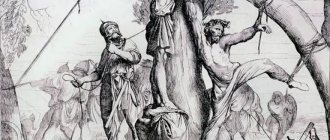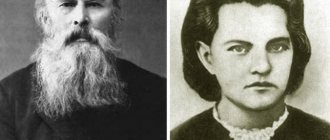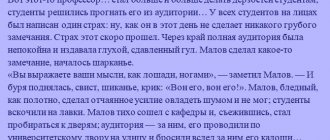- Essays
- According to paintings
- Gerasimov
- Gifts of Autumn
In the foreground of the picture we see green apples lying in a plate. There are six of them. One, turned towards us, has one red side. Or it is the red color reflected from a bouquet of rowan trees. Apples begin to be collected after the Apple Rescue. Nearby lies a half-eaten large sunflower disk. Beneath it is a second sunflower. The black seeds are large and just beg to be eaten. They contrast sharply with the huge yellow receptacle.
Next to them, lonely, with its leg up, lies a mushroom. Judging by the shape and color, it’s an oil can. A plate with apples, sunflowers and a green vase with a sprig of ripe rowan stand on a wooden table without a tablecloth. The table is moved close to the unpainted wooden window sill. It is slightly taller than him. Autumn has come, it is always generous with the harvest of berries, mushrooms, and apples.
There is a glass jug or vase on the windowsill. It contains a luxurious bouquet of rowan berries. It is so large that it completely blocks the window and immediately catches your eye. The branches bent under the weight of rowan clusters. Cold well water is poured into the container. Due to the effect of light refraction, the stems appear thicker than they actually are. A large bunch of mountain ash came off the branch and fell onto the windowsill. And it turns red like a bright spot in the rays of the sun. The berries seem to be burning with small bright sparks against the background of green leaves and an unpainted window. They reflect and change the color of nearby objects. The light from the window breaks through the bunches and leaves of rowan, onto the windowsill and table, creating a play of shadows and light there.
The picture is painted in bright autumn colors - red, green, black, yellow, wood color. It symbolizes wealth and prosperity. I remember the words of the poet Yesenin “...The red rowan bonfire is burning...”. And even though it cannot warm you in the literal sense of the word, it pleases the eye and warms the soul with its beauty.
Origin and childhood
Gerasimov comes from the Tambov province, the district town of Kozlov (today Michurinsk). Born on August 12, 1881 in the family of a peasant, now a merchant-cattle trader, as they said then, a prasol. From the south of the country, the father of the future artist brought cattle and sold them at the market. He didn’t acquire much wealth, but the family had a 2-story house. They lived simply, observing old customs. When son Alexander was born, the family already had a daughter, also Alexandra (a funny parental whim is to give children of different sexes the same names).
After parochial school, Alexander entered the district school. At the same time, the father begins to initiate the “heir” into trade matters.
As a child, Alexander Gerasimov discovered a penchant for drawing - friends and family were amazed at the similarity of the people and animals depicted to the originals. A turn in fate occurred after the artist S.I. arrived in Kozlov in the 1890s. Krivolutsky, a fellow educator from the Kirsanovsky district of the Tambov province, who graduated from the Academy of Arts in St. Petersburg. Krivolutsky opened a drawing school in Kozlov, Gerasimov began attending classes and became involved in the world of creativity. Soon the teacher “set the vector” for the student, already a young man, recommending that he go to Moscow, to the School of Painting, Sculpture and Architecture.
Studies
The parents were against it, but the 22-year-old son leaves and passes the entrance exams to the Moscow School with flying colors. Having started his studies in 1903, Gerasimov stayed here until 1915 - he wanted to learn new things.
First the painting department, then the architectural department. The teachers were Serov, Vasnetsov, Miloradovich, Klodt, Korin, Kasatkin, Gorsky, Arkhipov, Pasternak.
Konstantin Korovin, who often visited Paris, influenced Gerasimov’s development as a painter in a special way. "More life!" - he demanded from his students. The master's stories about French impressionism excited the minds of students, and Gerasimov's early paintings demonstrate this influence.
First successes and goals
Since 1909, Gerasimov has already been a regular participant in exhibitions held at the School. The first buyers and customers appeared. Thus, the famous Moscow writer V.A. Gilyarovsky did not miss a single student exhibition - he loved painting and was friends with artists. He could assess the magnitude of a student’s talent at first glance, as well as determine where he came from.
Seeing Gerasimov's potential, Gilyarovsky bought his exhibition works and also ordered portraits of his family members. Such participation of an influential and famous person was good moral and material support for the young artist.
Critics also highly appreciated the work of student Gerasimov - Alexander was mentioned in the Moscow press as a worthy landscape painter. “The rye was mowed down”, “Bolshak. Heat”, “Spring Festival”, “Warm Chernozem” and others are Gerasimov’s student paintings, for which the young artist was called in the press “the poet of spring, the poet of young awakening nature.”
The artist himself “loved life and the real in art,” so in his work he adhered to the traditions of Russian realism. He was attracted by Arkhipov's colors, Zorn's techniques and Claude Monet's light - he considered them sincere, poetic and integral. He himself was aimed at these qualities in art.
Graduation from College
In 1915, studies were completed. As a result, Gerasimov has 2 diplomas: he is now an artist of the 1st degree (he has a large gold medal) and an architect.
In the second specialty, the only result was the theater building, built in 1913 in the artist’s homeland (to replace the one that burned down in 1909). While still a student, Gerasimov took part in the design of the facade and decoration inside a new theater building in the modernized Empire style (Kozlov still stands today and is the pride of the city).
Other architectural projects were not destined to come to fruition - the desire for painting turned out to be stronger. The artist intended to devote his life to her.
Essay "Gifts of Autumn" based on Gerasimov's painting
Description of the theme: Autumn still life in Gerasimov’s painting “Gifts of Autumn”. Apples in a plate, two half-drained sunflowers, a vase with rowan bushes - all these are gifts that autumn gives us.
Luxurious rowan accent in Gerasimov’s painting “Gifts of Autumn”.
Alexander Gerasimov’s painting “Gifts of Autumn” is a typical still life. One of the popular still life motifs is a bouquet near a window. The window allows the artist to convey special lighting in the painting, the play of light and shadow.
If you take a transparent vase or jar for a bouquet, then you have the opportunity to observe how the stems and rays of light are refracted in the water. Gerasimov resorted to such a composition more than once, but he was especially successful with this picture. Fruits characteristic of this time of year are laid out on the table.
Most likely, the artist did not collect them on purpose, but took what was at hand. Otherwise he could have made a richer and more varied composition.
In the foreground, two half-drained sunflowers catch the eye. Maybe birds pecked them out, or maybe, while the artist was getting ready to paint a picture and preparing his brushes and canvas, some of the seeds were eaten by someone at home.
In any case, the artist very skillfully uses the contrast in sunflower flowers, which have always been a symbol of wealth. A small mushroom looks quite lonely next to them. Apparently, it grew up by chance somewhere on the threshold and the artist added it to the still life.
On the left side he placed a bowl of green apples.
And above all this rises the main image of the still life, its heart, its main color and semantic accent - a bouquet of rowan trees. Scarlet berries look more elegant than flowers. Heavy rowan tassels bent the branches.
An unusual autumn bouquet almost completely blocks the window and dominates the picture, setting the tone for it. The red color of abundant rowan clusters gives a reflection to everything around and changes the color of objects: everything gives off a ripe autumn redness, reddish highlights lie on everything around.
This shade of red creates the impression of luxury - simple, familiar autumn gifts look like a real treasure.
We are on Facebook
“Seasons of the Year” is a magazine about nature, culture and the surrounding world.
The materials can be used to introduce children to nature, to help schoolchildren, and in the work of educators and teachers.
Gerasimov “Gifts of Autumn”
Historical events in the country and Gerasimov’s work
In the year of graduation, the artist was drafted into the army - the First World War was underway. The service took place on a sanitary train that ran on the Galician front (Eastern Europe, the west of modern Ukraine). At the end of hostilities (1918) he was demobilized and went home.
The February and then the October revolution in Kozlov passed relatively calmly: meetings, meetings, demonstrations, demonstrations. Gerasimov joins a new life - he organizes the “Commune of Creativity of Kozlov Artists.” Together with colleagues from the Commune, he decorates theatrical productions, organizes exhibitions, and decorates city streets for the holidays.
At the end of August 1919, the cavalry of Mamantov (accent on the second syllable), a white general, captured the city of Kozlov for 40 days. During the raid, a lot of things created by Gerasimov at that time were destroyed.
In 1925, when political life in the country had more or less stabilized, Gerasimov went to Moscow. Here he gets a job as a decorator in two theaters at once, the Maly and operetta, and also joins the AHRR (Association of Artists of Revolutionary Russia), which became a replacement for the Association of Itinerants.
In the 1920s, the AHRR secured a quiet existence for itself by being faithful to the party line. Gerasimov's paintings of this period are dedicated to the image of Lenin and the Red Army commanders - Alexander Mikhailovich is one of the activists of the organization. But individual associations of artists continued to multiply, and in 1932 the AHRR was dissolved.
Active 1930s
The Union of Soviet Artists, created in 1931, became the main professional association in the state. In 1932, Gerasimov was elected to its board.
In 1934, the painter visited Germany, Italy, Turkey and France - from creative business trips he brought many sketches and sketches.
In 1936, the first personal exhibition of A.M. was held in Moscow. Gerasimova - this is how the artist “celebrated” the 25th anniversary of his creative activity. More than 100 works, watercolors, paintings and graphics, were presented.
In the 1930s, the artist was mainly engaged in portrait painting. He painted both individual and group portraits. Among them, images stand out: actress Tarasova, ballerina Lepeshinskaya, polar explorer Papanin, artist Moskvin. The painting “The First Cavalry Army,” large-scale and multi-figured, received the Grand Prix at the World Exhibition in France in 1937.
The attraction to impressionism, characteristic of the artist at the beginning of his creative career, was finally replaced by socialist realism by his mid-fifties.
From 1939 (to 1954) Gerasimov took the post of chairman of the organizing committee (head) of the Union of Artists of the USSR.
Honored 1940s and 1950s
With the beginning of the Great Patriotic War, Alexander Mikhailovich left Moscow for evacuation, but returned a year later. Now the characters in his paintings are war heroes, home front workers, comrades and workmates. A contribution to the future Victory was the donation of a substantial amount of personal funds to the Defense Fund.
At the end of July 1943, Gerasimov and three of his colleagues (Ioganson, Mukhina, Merkurov) Fr. They became the first holders of the honorary title, which was approved legislatively at the highest state level a few days ago.
After the war, an exhibition that included Gerasimov’s works swept across Europe with great success. In 1947, the artist was in Yugoslavia when the news reached him that he had been elected president of the All-Union Academy of Arts. The All-Russian Academy, founded in 1932, was transformed into the USSR Academy of Arts. Gerasimov became its first head. He was in charge until 1957: he tirelessly improved the structure of the educational institution, turning it into the creative center of the country, providing an organizational foundation for the creative process.
In 1951 he became a doctor of art history. I managed to do everything: in Moscow, the Institute named after him was added to my worries. Surikov, in Leningrad Institute named after. Repin and the Academy, everywhere he was the head of the state commission for awarding diplomas.
Visited China, India, Egypt. Created a series of illustrations for Gogol's Taras Bulba. On his 80th birthday he was awarded the Order of the Red Banner of Labor.
And at the same time he wrote a lot - he was in love with life and people. The artist was interested in personality, intellectual and significant. The painter himself explained his, as he said, uncontrollable desires to capture colorful images: “I love the strong and bright in nature, I look for the same in a person...”.
Essay based on Gerasimov’s painting “Gifts of Autumn”
The paintings of Alexander Gerasimov adorn many museums. His canvases reflect Russian reality: portraits of his contemporaries, Russian landscapes and amazing still lifes. All of them evoke nothing but admiration in the viewer.
One of Alexander Mikhailovich’s paintings is called “Gifts of Autumn.” In this still life, the painter showed autumn nature at the moment of its new manifestation.
A small but bright bouquet near the window, which reflects the play of light and shadow, became the basis of the painting by Alexander Gerasimov.
The central part of the picture is a large glass and transparent jar with water. The top of this jar is not visible, so it could be a tall decanter. The artist placed tall red flowers with large and strong stems in it. These are rowan berries, like flowers. The flowers are tall and the last rays of the sun are playing merrily on them.
But the jar itself attracts attention, which the painter decided to use in order to show the viewer how the rays of the sun act. They do not illuminate the entire jar, but only select the places for illumination that are easiest to reach.
The thick stems seem to be refracted as they fall into the jar.
It is worth noting that the painter Alexander Gerasimov had already resorted to a similar image in his magnificent canvases. But in this autumn still life he managed to do it most successfully. Next to the bank, the artist placed a small dark-colored vase. It is not transparent, the stems of the flowers are not visible.
It is the clear opposite of a glass jar: dark and dull. Bright red flowers were also placed in it.
Both the jar and the vase stand on a small windowsill. It can be seen that the window is not very wide, most likely, and the house where this autumn still life was placed is small. Maybe it’s even a country house, since outside the window you can see the foliage of trees and bushes, and a dark day.
On the window sill on the left there are small bright shades of sunlight playing. The artist placed two small sunflowers next to the vases. The first sunflower is not whole, but its half is broken off. And the second one, although whole, has no seeds in it, only half.
This is such a slight hint from the author of the picture that summer has passed and now all that remains is for a person to be content with the remnants of the summer harvest.
The artist was able to use contrast in the colors of the sunflower image, showing how rich this harvest year was. Yellow, red and black are a wonderful combination of colors that reflect the fall mood.
Next to these small sunflowers lies a small dark mushroom, which probably grew somewhere very close to this place.
And so the artist, creating an unusual still life, realizing that this fungus is also a gift of autumn, decided to include it too.
On the left in the painting by Alexander Gerasimov there is a small flat plate where the author of the painting placed small green apples. The result was an unusual but charming autumn bouquet.
Red berries set off all the other objects in the still life; they seem to attract the attention of the audience. Therefore, the main meaning of the picture lies precisely in them. Red is the main color of Alexander Mikhailovich’s paintings.
A small brush of rowan lies on the windowsill, like amber beads that delight every girl.
Gerasimov’s painting reminds every viewer of how beautiful the autumn season is, and how many bright colors and impressions it can give to a person. And how many gifts this time has prepared for people! And every person uses these gifts, but does not notice her charm and charm at all. And autumn is not a sad time, but juicy and rich, if you look back and see the beauty around you.
Personal life
Gerasimov’s gallery contains many picturesque evidence of his happy family life. He loved his older sister, whom he called Sanya, his wife Lydia Nikolaevna, and his only daughter Galina. Their portraits radiate warmth and light. Lush flower bouquets, the play of sunlight on many of the master’s canvases also speak of the master’s enthusiasm and spiritual sensitivity.
Lydia Nikolaevna, the artist’s wife, was an interesting person: in her youth she studied with Stolypin’s daughters, when Pyotr Arkadyevich was the governor of Saratov, during the Civil War she worked in Kozlov, at the headquarters of the Southern Front, she had to meet with influential revolutionaries, with Trotsky, for example. She became the artist's faithful friend, who made his home cozy and hospitable - she embroidered curtains, tablecloths, and napkins with her own hands.
Gerasimov visited many countries, but upon returning to Russia the very next day he strove to his native Michurinsk. He confessed to his sister that any stones in his home were dearer to him than the most luxurious foreign hotels.
Essay based on Gerasimov's painting Gifts of Autumn, grade 6
In the foreground of the picture we see green apples lying in a plate. There are six of them. One, turned towards us, has one red side. Or it is the red color reflected from a bouquet of rowan trees.
Apples begin to be collected after the Apple Rescue. Nearby lies a half-eaten large sunflower disk. Beneath it is a second sunflower. The black seeds are large and just beg to be eaten.
They contrast sharply with the huge yellow receptacle.
Next to them, lonely, with its leg up, lies a mushroom. Judging by the shape and color, it’s an oil can. A plate with apples, sunflowers and a green vase with a sprig of ripe rowan stand on a wooden table without a tablecloth. The table is moved close to the unpainted wooden window sill. It is slightly taller than him. Autumn has come, it is always generous with the harvest of berries, mushrooms, and apples.
There is a glass jug or vase on the windowsill. It contains a luxurious bouquet of rowan berries. It is so large that it completely blocks the window and immediately catches your eye. The branches bent under the weight of rowan clusters. Cold well water is poured into the container. Due to the effect of light refraction, the stems appear thicker than they actually are.
A large bunch of mountain ash came off the branch and fell onto the windowsill. And it turns red like a bright spot in the rays of the sun. The berries seem to be burning with small bright sparks against the background of green leaves and an unpainted window. They reflect and change the color of nearby objects.
The light from the window breaks through the bunches and leaves of rowan, onto the windowsill and table, creating a play of shadows and light there.
The picture is painted in bright autumn colors - red, green, black, yellow, wood color. It symbolizes wealth and prosperity. I remember the words of the poet Yesenin “...The red rowan bonfire is burning...”. And even though it cannot warm you in the literal sense of the word, it pleases the eye and warms the soul with its beauty.
Essay description of the painting Gifts of Autumn by Gerasimov
Alexander Mikhailovich Gerasimov painted about three thousand paintings. He was a versatile artist, painted still lifes, portraits, and landscapes. His paintings are known all over the world; they adorn a lot of museums.
One of these paintings is the painting “Gifts of Autumn”.
The picture itself suggests that its creation was spontaneous. After all, if you look closely, you can see that the artist used everything that was next to him at the time of visiting the art muse. The main inspiration was still the mountain ash.
Most likely, she grew up right next to the artist’s house. She was so beautiful that I wanted to capture her at this wonderful moment.
Alexander Mikhailovich cut so many branches that the result was a bouquet strewn with lush clusters of rowan berries, which did not fit into one vessel.
The berries and leaves take on a rich color from the bright sunlight breaking through the window. Gerasimov was able to play with these rays in such a way that the play of shadow and light is clearly visible on the canvas.
Rowan leaves remind of the bygone warm summer with their still green color. But the clusters said that autumn had come, the berries were large, fiery red, like a decoration of this tree, which is characteristic of this miracle only with the onset of autumn. The red shadows that fell on the table gave harmony to everything depicted.
There is a dish with green apples near the vase. They are like a complement to the green leaves belonging to the mountain ash. In the very center, a pair of flowers reminiscent of the summer sun lay neatly on top of each other - yes, this is a pair of sunflowers.
One of them is broken in half, and the second somewhere has lost part of its black seed houses. Perhaps these houses were pecked out by chicks or taken by local children.
In the right corner, near the sunniest flower, lies an upside-down mushroom, which does not seem lonely at all, but on the contrary adds some kind of complement to the whole still life.
Seeing this work of the artist, you are amazed and cannot understand how he was able to so vividly convey everything that is depicted on it. There is a constant desire to touch a rowan tree and pick up a delicious apple.
6th grade








